Cracking the New SAT with 4 Practice Tests, 2016 Edition (2015)
Part VII. Practice Tests
Chapter 23. Practice Test 2: Answers and Explanations
PRACTICE TEST 2 ANSWER KEY
Section 1: Reading
1.A
2.B
3.B
4.D
5.C
6.A
7.D
8.C
9.B
10.C
11.C
12.B
13.D
14.B
15.B
16.D
17.C
18.A
19.B
20.B
21.D
22.B
23.A
24.D
25.D
26.A
27.B
28.D
29.B
30.B
31.D
32.C
33.D
34.A
35.C
36.B
37.C
38.B
39.D
40.A
41.D
42.C
43.C
44.B
45.B
46.C
47.D
48.A
49.C
50.D
51.D
52.A
Section 2: Writing & Language
1.B
2.D
3.A
4.C
5.B
6.D
7.B
8.C
9.A
10.B
11.D
12.D
13.C
14.D
15.A
16.C
17.B
18.A
19.D
20.B
21.A
22.D
23.D
24.B
25.C
26.A
27.B
28.A
29.C
30.D
31.A
32.D
33.C
34.A
35.C
36.B
37.A
38.C
39.D
40.B
41.C
42.A
43.B
44.D
Section 3: Math (No Calculator)
1.C
2.C
3.D
4.A
5.A
6.D
7.D
8.D
9.C
10.C
11.A
12.D
13.B
14.A
15.C
16.28
17.0
18.94
19.7
20.
Section 4: Math (Calculator)
1.B
2.A
3.B
4.D
5.C
6.D
7.A
8.B
9.C
10.A
11.B
12.D
13.D
14.B
15.C
16.A
17.B
18.C
19.D
20.B
21.D
22.D
23.C
24.A
25.D
26.A
27.B
28.A
29.D
30.B
31.30
32.4
33.13.5
34.2 or 
35.5
36.5,406
37.860
38.250
PRACTICE TEST 2 EXPLANATIONS
Section 1: Reading
1. AWhile Jane resists Mr. Rochester, the first sentence of the passage indicates that her conscience and emotions are both favorably inclined toward Mr. Rochester. Because she has positive feelings toward him, (A) is an accurate description of her attitude towards Mr. Rochester. Although Mr. Rochester perceives Jane to be uncaring, (B) is incorrect because the narration indicates that she does in fact care, though she resists her own feelings. Similarly, (C) is incorrect because the first sentence tells us she has positive feelings for Rochester. Because Jane acts calmly, ignoring her emotions, she cannot accurately be described as reckless. Therefore, (D) is also incorrect.
2. BBecause questions 2 and 3 are general paired questions, consider the question given in question 2 and the textual evidence given in question 3 at the same time. Question 2 asks for the reason Jane refused Rochester’s advances. Consider the lines referenced in the answers to question 3 and whether they support any of the answers in question 2. Choices (A), (C), and (D) of question 3 do not support any of the answer choices in question 2, so they can be eliminated. Choice (B) of question 3 (I will hold to the principles received by me when I was sane, and not mad—as I am now) provides support only for (B) on question 2, so (B) must be the answer to question 2 and question 3. These answers make sense because they indicate that Jane resists Rochester because she wishes to hold to her principles.
3. BSee explanation for question 2. As noted above, (B) of question 3 (I will hold to the principles received by me when I was sane, and not mad—as I am now) provides support only for (B) on question 2, so (B) must be the answer to question 2 and question 3. These answers make sense because they indicate that Jane resists Rochester because she wishes to hold to her principles.
4. DThere is no evidence that Jane is literally insane. Rather, she is speaking metaphorically about the conflict between her reason and her desires. Therefore, (A) is wrong. Because Jane says the law (not her mental state) has been given by God, (B) is incorrect. As Jane says that her insanity tempts her to disregard the worth of her principles, and it is her principles that are preventing her from giving in to Mr. Rochester, her insanity is tempting her to give in to Rochester. Therefore, (C) is wrong; her insanity does not urge her to reject Rochester, but rather to accept his advances. Choice (D) is correct because her feeling of insanity is directly related to her emotions, as can be seen by the phrase with my veins running fire, and my heart beating faster than I can count its throbs, which Jane provides to explain why she feels insane.
5. CBecause wrought describes Mr. Rochester’s fury, and the passage says that his fury has reached its highest, wrought means something like “increased.” Because hammered has nothing to do with increasing fury, (A) is wrong. Choice (B) also does not have anything to do with “increased.” Therefore, it is wrong. As excited could mean “increased” when applied to someone’s emotions, (C) accurately describes the passage’s use of wrought. Because wrung means squeezed and twisted, (D) does not describe the passage’s use of wrought.
6. AChoice (A) is correct because Mr. Rochester describes Jane’s soul as strong and her body as weak in paragraph 5. While paragraph 1 states that Rochester loves Jane, and paragraph 4 states that he is angry with her for refusing his advances, Rochester is angry for the entirety of paragraph 5. Therefore, it cannot contrast his love with his anger, and (B) is incorrect. Though Rochester speaks of a cage, he never actually mentions a bird. Therefore, (C) should be eliminated. Similarly, Rochester only refers to Jane’s purity. Because he never calls Jane impure, (D) cannot be correct.
7. DBecause Rochester is speaking metaphorically, not about a literal convict, (A) is incorrect. Because he is talking about Jane, not himself, (B) cannot be correct. When Rochester refers to breaking the prison and Jane’s body, you can tell that the inmate’s prison refers to Jane’s body, not the ideals of the time. Therefore, (C) is incorrect. The inmate refers to Jane’s soul, so (D) accurately describes Rochester’s use of inmate.
8. CThink about the evidence in the passage that helped you answer the previous question: Rochester is using the word inmate to refer to Jane’s soul trapped in her body. Because (A) makes no mention of either soul or body, (A) is incorrect. Because (B) refers only to Jane’s body, it cannot be correct. Because (C) mentions both Jane’s spirit and body (her brittle frame), the sentence provides good support for the answer to the previous question. Because (D) makes no mention of either soul or body, it is incorrect.
9. BBecause Jane is having a harder time resisting Rochester now that he is sad, worse means something close to harder. Because less desirable, of lower quality, and unskillful all mean things other than harder, you can eliminate (A), (C), and (D). Because harder matches more difficult, (B) accurately describes the passage’s use of worse.
10. CPathos refers to Jane’s emotions, so the paragraph depicts Jane overcoming her emotions. Therefore, (A) cannot be correct. Jane makes no allusion to social conventions, which makes (B) incorrect. However, because the paragraph depicts Jane overcoming her emotions, (C) is a good description of Jane’s values. Since Jane battles to overcome her feelings, (D) is not an accurate description of her values.
11. CClinton’s speech speaks out against women not being treated as equals in a variety of ways across the world. She advocates that these injustices should be put to right. Choice (C) best reflects this idea. Although Clinton is a critic of how women are treated worldwide, she does not counter any arguments, so eliminate (A). She does not take a scholarly approach to analyze women’s place in society, so eliminate (B). Clinton is not mediating between two parties, so eliminate (D).
12. BAlthough women play many different roles in society, many of these roles are not appreciated. Choice (B) most accurately reflects this meaning. Choices (A), (C), and (D) have meanings that are related to the word valued but are not used in the context of the word’s use in the passage.
13. DClinton discusses the importance of conferences in compelling people to consider important issues. She then mentions the conference in Nairobi as helping to bring to light the crisis of domestic violence. Choice (D) is, therefore, the best answer. The passage does not claim that the crisis of domestic violence was not solved, so eliminate (A). The passage does not discuss anyone questioning the reason for holding the current conference, so eliminate (B). Although Clinton does discuss the idea that the experiences of women sometimes tend to go unnoticed, this is not her reason for mentioning the conference in Nairobi. Eliminate (C).
14. BThink about the evidence in the passage that helped you answer the previous question: It is conferences like this that compel governments and peoples everywhere to listen, look, and face the world’s most pressing problems. She then mentions the conference in Nairobi as helping to bring to light the crisis of domestic violence. Choice (B) provides the most support for why Clinton mentions the conference in Nairobi. The current conference was not held because of the conference in Nairobi, so eliminate (A). Women being the primary caretakers of the world is not the reason for mentioning the conference in Nairobi, so eliminate (C). Women dying from preventable diseases is not the reason for mentioning the conference in Nairobi, so eliminate (D).
15. BClinton discusses how some women are able to attend a conference that speaks out against the inequalities against women, while others are not able to do so. Choice (B) most accurately reflects this idea. Clinton does not draw a difference between people who work in schools and hospitals, so eliminate (A). Clinton does not mention employed women, unemployed women, or women who can or cannot vote, so eliminate (C) and (D).
16. DChoices (A), (B), and (C) are each discussed in paragraph 4, so eliminate these answer choices. The passage does not discuss women suffering from widespread unemployment, so (D) is the best answer.
17. CIn paragraph 4, Clinton discusses those women who have a voice standing up for those women who are unable to stand up for themselves. Choice (C) most accurately reflects this meaning. Choices (A), (B), and (D) have meanings that are related to the word speak but are not used in the same context as this word is used in the passage.
18. AIn paragraph 8, Clinton argues that women’s rights are also human rights. Choice (A) most accurately reflects this idea. Women’s attendance at the conference is not discussed in this paragraph, so eliminate (B). Clinton is not advocating that women’s rights have a special nature, just that these rights are the same as human rights, so eliminate (C). Clinton does not suggest that we no longer need to focus on women’s problems; this is the opposite of what is discussed in the passage, so eliminate (D).
19. BThink about the evidence in the passage that helped you answer the previous question: In paragraph 8, Clinton argues that women’s rights are also human rights. Choice (B) provides the most support for the rhetorical effect of the phrase discussed in the previous question. Although Clinton discusses the respect and protection of women’s rights, this is not the phrase that best supports the rhetorical effect of the discussed phrase, so eliminate (A). Giving examples of the specific rights in question does not provide the best support for the rhetorical effect of the discussed phrase, so eliminate (C). The attendance of women at the conference is not related to the discussed phrase, so eliminate (D).
20. BIn paragraph 2, Clinton discusses the experiences of women throughout the world: Yet much of the work we do is not valued—not by economists, not by historians, not by popular culture, not by government leaders. Choice (B) most accurately reflects this idea. Clinton does not state that these leaders are purposely working against the prosperity of women, so eliminate (A). Choice (C) is contradicted by what the passage states, so eliminate this choice. Although these leaders may not value the work of women, the passage does not state that these leaders have made it unacceptable to discuss women’s rights, so eliminate (D).
21. DThe graphic shows poverty rates in America divided by gender and age. Across all age groups, women experience higher rates of poverty than their male counterparts. This falls in line with the passage’s assertion that women comprise 70 percent of the world’s poor. Therefore, (D) is the best answer. Choice (A) is incorrect because, while the graphic shows a high gender disparity among those 65 and older, it refers only to American poverty rates. The graphic actually states that 15.4 percent of American women 18 to 65 are impoverished, not that they make up that percentage of the world’s poor. Therefore, (B) is incorrect. And there is no mention of how many children are impoverished worldwide in either the graphic or the passage, so (C) is incorrect.
22. BThe next-to-last sentence of the passage states that Seen throughout the procession is that balance of the monumentally simple and the actual, and goes on to list several more types of balance, that Heraclitus, the philosopher, wrote of in the sixth century B.C. This is support for (B). While the author does discuss the representation of the passage of time in the frieze, this idea is not connected to Heraclitus, so (A) is out. The mention of Heraclitus also does not support the idea that the frieze is characteristically Greek, so (C) doesn’t match. Choice (D) is tempting, if the entirety of the sentence mentioning Heraclitus isn’t included; however, the balance mentioned isn’t between mortals and the goddess Athena.
23. AIn the first paragraph of Passage 1, the author proposes his idea of what the frieze probably represents. In the second, he describes the frieze. This matches (A). Choice (B) may seem close at first because the author does indicate that the subject of the frieze is still a matter of scholarly dispute. However, he does not question someone else’s interpretation, so (B) is out. Choice (C) falls into the category of “too narrow”: The author does describe the frieze, but only in paragraph 2. Choice (C) doesn’t take paragraph 1 into account. Since no historical overview is given, (D) is also not the answer.
24. DBy using the word unparalleled, the author is saying that it is unusual to see a representation of a festival in classical Greek art that shows deities in attendance. Choices (A), (B), and (C) do not match the meaning of “unusual,” and (D) does. Therefore, (D) is the best choice.
25. DPassage 2 begins with the first paragraph describing ways that the particular piece of art in question is unusual in the world of classical Greek art: It shows deities attending a festival, including Athena, and they are ignoring the peplos. This represents a flagrant breach with tradition that requires explanation. Paragraph 2 continues with an explanation of what it cannot represent. Since the author does not say that the frieze cannot depict the Panathenaic procession, (A) does not match. The author also does not discuss the passage of time, so (B) can be eliminated. While the author goes on to describe the heroes of Marathon, the question is asking about the purpose of the first two paragraphs, so (C) is a tempting trap answer but must be eliminated. Choice (D) comes the closest to what the author is doing in the first two paragraphs, describing problems in the traditional interpretation of the frieze.
26. AParagraph 2 begins by discussing what a classical Athenian, or resident of Athens, would not have thought as he looked at the frieze, that is, that it was a representation of himself. Continuing into the second sentence, mortal could be replaced by classical Athenian, because the subject must be something greater than a resident of Athens. Therefore, (A) is the closest match, and (B), (C), and (D) do not fit.
27. BParagraph 2 begins by discussing what a classical Athenian, or resident of Athens, would not have thought as he looked at the frieze: “there I go” or even more vaguely “there we go.” The next sentence tells us that the subject of the frieze must be more than mortal, or more than about the classical Athenian looking at it. Putting these together, we can surmise that when the author says that the classical Athenian wouldn’t say “there I go,” he is saying that the frieze is not about the classical Athenian. Paragraph 3 confirms this idea by saying we must rule out…that it is a contemporary or generic statement of the Panathenaic procession conducted by the citizens…. Since there was never a discussion of the figures themselves and whether they represented individual citizens, (A) is not the best match. Choice (B) does match pretty closely, so leave it in. Choice (C) has more to do with who participated in the procession rather than the subject of the frieze, so eliminate (C). Choice (D) goes too far, because the author never says that the subject of the frieze should be obvious to modern viewers. Choice (B) remains as the correct answer.
28. DThink about the evidence in the passage that helped you answer the previous question: Support for (B) in question 7 comes from paragraph 2 and paragraph 3, so (A) and (B) can be eliminated. While it may be true that Moreover, the explanation must have been apparent to the classical Athenian who knew this background, this does not support the idea that the frieze cannot represent a human event, so eliminate (C). Choice (D) directly supports (B) in question 27, and is therefore the best answer.
29. BThe author of Passage 2 proposes that the frieze shows the fighters of Marathon celebrating the prime festival of the goddess Athena…as a thanksgiving for her aid at Marathon and afterwards. This ties into (B), Athenian men who died in battle at Marathon. There is no indication that the author believes the youths were from around the time the Parthenon was built, so eliminate (A). Choice (C) is too broad because it includes all people of Marathon who were worshipped as heroes, whereas the author specifies the fighters of Marathon, so eliminate (C). Choice (D) contradicts the author’s description that the frieze is a representation of the fighters, not purely divine participants, so eliminate it. Choice (B) is the answer.
30. BPassage 1 does not focus on determining the subject of the frieze—that’s only in the first paragraph. Eliminate (A). Passage 2 considers how Greek citizens might have viewed the frieze, but Passage 1 does not. Eliminate (C). Passage 1 also does not entirely reject the traditional perspective, so eliminate (D). Passage 1 does give a detailed description of the figures in the second paragraph, so (B) is the correct answer.
31. DThink about the evidence in the passage that helped you answer the previous question: Passage 1 gives a detailed description of the figures in the frieze in the second paragraph. Only (D) references lines that give a detailed description of figures in the frieze, so (D) is the correct answer.
32. CChoice (A) is wrong because the mules are not unusual. They are an example familiar to many people to help readers understand what the author is describing. Choice (B) is wrong, since the mules are not part of a counterargument. Choice (D) is half right, in that sterile mules are part of the larger argument that the whiptails are unusual, but the specific purpose of mentioning the sterile mules at that point in the passage is to give an example of why scientists believe that hybrids are sterile. Thus, (C) is correct.
33. DThe lizards are unusual to the point of being remarkable, so (D) is correct. They are not especially beautiful, (A), or conspicuous, (B). Choice (C) is a trap because aggressive is related to striking but not contextually correct in this instance.
34. AThe scientists do seem to be friends, as stated in (D), but the best description of their relationship in this article is as a team of scientists working on parthenogenesis, so (A) is correct. They are not rivals, so (B) is incorrect, and Stowers is an institute where Dr. Neaves served as president, so they were not trying to disprove theories from Stowers, which makes (C) incorrect.
35. CChoices (A) and (B) are too extreme, so they are incorrect. Choice (D) refers to something that often happens in evolution, but evolution itself doesn’t isolate populations. Choice (C) mirrors what is said in the passage.
36. BThink about the evidence in the passage that helped you answer the previous question. Choice (B) is correct, since the line The evolution of a new animal species is usually a drawn-out affairsupports the idea that evolution usually takes many years to happen. Choices (A), (C), and (D) do not support this and are therefore incorrect.
37. CThe Doctor thought it was a good time to move forward, due to the new technology available, so it was an opportune moment, (C). The passage implies that it’s taken a long time, but an hour late, (B), is too short a time. It’s not a festival, so (A) is incorrect, nor is it a lofty ideal, making (D) incorrect.
38. BChoices (A), (C), and (D) are mentioned in the passage and are aspects of parthenogenesis. Choice (B) is mentioned, but only the female lizards can clone themselves, so any cells from a male whiptail would be useless for parthenogenesis.
39. DChoice (A) is the opposite of what the passage says, so it’s incorrect. The lizards have different sets of chromosomes. The whiptails weren’t discovered in the 1960s—their genetic makeup was found to be strange, so (B) is wrong. The lizards don’t require a male and female, (C), but the clones come only from female whiptails, so the clones must be female. Thus, (D) is correct.
40. AThink about the evidence in the passage that helped you answer the previous question: Choice (A) clarifies that the clones come only from female whiptails, so the clones must be female. Choices (B), (C), and (D) do not support this and are therefore incorrect.
41. DChoices (A) and (C) aren’t definitive enough and (B) is too general, making them all incorrect. Choice (D) addresses the author’s argument that mating animals in captivity defies ideas about how species evolve. If lizards never clone themselves in the wild, then species outside of the lab don’t evolve through cloning. Thus, (D) is correct.
42. CThe word somehow implies that scientists still don’t understand how female whiptails clone themselves, so (C) is correct. Choice (A) is wrong since it uses the word switch in an incorrect and misleading way, while (B) is too vague and doesn’t answer the question. Choice (D) addresses why the whiptails clone, but the sentence is referring to how they do it, so (D) is incorrect.
43. CLook earlier in the sentence for the phrase the Earth’s surface sank more than 1 mile. Go through the answer choices to find one that matches this description. Choice (C) is going to be the best match, since a crater is a “large, bowl-shaped cavity in the earth.” Eliminate (A), (B), and (D), as none of them match this physical description.
44. BThe second paragraph primarily discusses the extensive time range of volcanic eruptions, starting as far back as 400,000 years ago and as recently as 600 years ago. Use POE to find an answer to match this information. There is no evidence of another eruption this century based on the passage, so eliminate (A). Choice (B) works since it shows the large range of time in geologic terms. Choice (C) almost works, but the author is not trying to be just ironic. The information has no relevance to the paragraph, so get rid of (C). Choice (D) is incorrect because a relative term doesn’t fit, since recently isn’t being compared to any other variables. Choice (B) is the best answer.
45. BThe pronoun that precedes temblor, so it must reference something earlier in the previous sentence. The first sentence discusses a magnitude 5.4 earthquake struck 6 miles southeast of the caldera, so (B) is the best answer because the temblor ended two decades of low quake activity.
46. CThe third sentence in paragraph 7 states that the geologists studied trees that were dying on Mammoth Mountain from carbon dioxide, and that this would often precede volcanic eruptions. This information would indicate the possibility of a volcanic eruption. Choice (C) is a good match for this information. There is no evidence to support (A) and (B), so eliminate them. There is no mention of geodetic equipment in this paragraph, so get rid of (D) as well. Choice (C) is the best answer.
47. DThink about the evidence in the passage that helped you answer the previous question: The geologists are monitoring the caldera to try to predict a future eruption. Use POE to find the best reference from the passage to the previous question. Eliminate (A) because that sentence talks about eruptions from centuries ago. Choice (B) does not reference geologist activity at all, so get rid of it. Eliminate (C) because it discusses the equipment, not the geologists. Choice (D) works because it details studies from the USGS regarding forms of evidence that often precede volcanic eruptions.
48. AThe final sentence in the last paragraph states that geologists think that the chances of an eruption in the area in any given year are quite small. This contradicts the information in (B) and (C), so eliminate them. Earthquakes are only a small part of the overall passage, so eliminate (D) because it is too limited. Choice (A) is the best answer.
49. CUse POE to find the best answer choice supported by the passage. Choice (A) is incorrect since it was both the Inyo Craters and Mono Craters that erupted 600 years ago. Choice (B) almost works, but the passage never suggests that Mammoth Mountain is actually active, as opposed to the larger chain—the Long Valley Caldera—it’s part of. Choice (C) is a good fit since the seventh paragraph states that symptoms of volcanic unrest may persist for decades or centuries at large calderas, such as Long Valley Caldera. The information in (D) is mentioned in the first paragraph, but there is no evidence that it’s referencing Mammoth Mountain, so eliminate it. Choice (C) is the best answer.
50. DThink about the evidence in the passage that helped you answer the previous question: The seventh paragraph states that symptoms of volcanic unrest may persist for decades or centuries at large calderas, such as Long Valley Caldera. This sentence is referenced by (D), while the other choices do not relate to the correct answer to the previous question. Therefore, (D) is the best answer.
51. DThe last few sentences of the seventh paragraph state that symptoms of volcanic unrest may persist for decades or centuries at large calderas, such as Long Valley Caldera. Studies indicate that only about one in six such episodes of unrest at large calderas worldwide actually culminates in an eruption. The swelling of the Long Valley Caldera is part of these symptoms, so this basically says that there is no definitive outcome that results from them. Choice (D) is a good analogy for this information.
52. A2015 is at the far left end of the graph, at which point the line indicating the number of cumulative earthquakes hits above the 1.2 line. However, each number on the right y-axis needs to be multiplied by 105, so the number of cumulative earthquakes is actually greater than 120,000. Therefore, (A) is the correct answer. Choice (B) is incorrect for the same reason; earthquakes per week are tracked on the right axis, not the left. Choice (C) is incorrect because 1.2 needs to be multiplied by 105. Choice (D) is incorrect because cumulative earthquakes are tracked on the right y-axis, not the left.
Section 2: Writing and Language
Park Rangers, Naturally
1. BSince this question is asking for the answer choice that would NOT be acceptable, then the underlined portion is correct as it stands. Choice (B) is the correct response because the other answer choices match the underlined portion in that they set off the abbreviation NPS from its official name of National Park Services.
2. DSince there doesn’t seem to be a common thread being tested, use POE to go through the answer choices. Eliminate (B) and (C) since pulchritudinous and pretty basically mean the same thing, making these choices interchangeable and impossible to choose between. Go back to the passage and notice that it already uses the phrase marveled at the natural beauty, so to use another word to describe its beauty again would be redundant. Therefore, eliminate (A) as well. Choice (D) is the best, and most concise, response.
3. ANotice the question! This question asks for a choice that will include detail to clarify day-to-day operations. Look at the next sentence that describes the activities of the park rangers. It states that they are in charge of the park’s upkeep and that they maintain the balance between the wildlife and plant species and the human visitors. Both of these correspond with the underlined portion of maintenance and tours. Nothing is stated about the length of the tasks, whether or not they are repetitive or the political aspects of them, so eliminate (B), (C), and (D). Choice (A) provides the detail being asked for and is the best response.
4. CThe idea before the punctuation, These park rangers are responsible for the upkeep of the parks, is a complete idea, as is the clause, their main responsibility is to maintain the balance between the wildlife and plant species and the human visitors that come to the parks every day, that follows it. Therefore, a comma alone cannot separate two complete ideas, so eliminate (A) and (D). Also eliminate (B) since there needs to be some punctuation to separate two complete ideas. Choice (C) is the best response since a dash (HALF-STOP punctuation) can be used to separate these complete ideas.
5. BThe paragraph describes the park rangers as scientists, educators, and professionals with backgrounds in law enforcement and firefighting. Look for an answer that is consistent with this type of diversity. Choice (B) is the best match. Eliminate (A) since pollution is not talked about in the paragraph, as well as (C) because the paragraph is not interested in the visitors to the park. Ecology is too limited for (D), so eliminate it as well.
6. DLook to the previous sentence describing some of the park rangers and notice the phrase Some are scientists who revel. Since the next sentence is also describing the park rangers, it needs to be consistent and parallel with the previous sentence, so it should be Some are educators who help. Choice (D) is the correct response.
7. BNotice that the answer choices are pronouns, so look back at the current sentence and find what the pronoun them is referencing, which might be unclear since both posts and municipal services are used in the sentence. Eliminate (A) and (C), which are ambiguous, and (D) because it’s singular and ambiguous. Choice (B) is the most precise and clear response.
8. CUse POE to go through these answers and find the most clear and concise response. Choice (A) is awkward since visitors are on the rise doesn’t necessarily refer to their numbers, so eliminate it. Choice (B) is incorrect as poised on the rise is an idiom error and should be poised to rise. Choice (D) is awkward, unclear, and redundant, as poised on the rise seems to be referring to the numbers, which are also described as growing. Choice (C) is the best answer.
9. ACheck the underlined portion of this sentence that states that the visitation numbers peaked in 1987 and compare it with the chart. This information is true, as is the second phrase, the general trend has been on a steady rise, so keep (A). Eliminate (B) because 1987 isn’t really the mid-1980s and has not tapered off. Choice (C) is simply incorrect, and (D) can be eliminated since the growth has been somewhat erratic and not linear. Choice (A) is the best response.
10. BSince the question is asking for the LEAST acceptable response to the underlined portion, the underlined word is correct. Use POE to eliminate all answers that are similar in meaning to foretold. Choice (B) is the odd man out since stated just means “to express or declare,” whereas the other choices mean “to predict.” Therefore, (B) is the correct answer.
11. DThe idea before the punctuation, The park-ranger workforce is so diverse, is a complete idea, as is the clause, there are actually a few common attributes among park rangers, that follows it. Therefore, a comma cannot separate two complete ideas, so eliminate (A). Look at (C) and (D), since the transition words because and although are exact opposites, and then refer back to the sentence to see if the two ideas are complimentary or contrasting. Since the words used in the sentence are diverse and a few common, pick the transition word that indicates a contrast. Choice (D) is the best answer.
The Ferry Godfather
12. DSentence 2 starts with the phrase this part. So, since a pronoun is used, go back and find the noun it’s referencing. Sentence 4 states that Lincoln granted a special provision for that part of Virginia, so the pronoun this is referring the part of Virginia. Therefore, sentence 2 should go after sentence 4, so (D) is the correct answer.
13. CTake a look at the answer choices and see that this question is testing pronouns. Go back earlier in the sentence to find what the pronoun is referring to. It’s the United States, which is a collective noun and therefore singular. Eliminate (A) and (B). Eliminate (D) as well since a contraction is not necessary here. Choice (C) is the correct answer.
14. DThis question is testing comma usage, so check if the comma is separating two complete ideas or if it’s necessary to break up the incomplete ideas. Neither appears to be the case, and this sentence does not need a break. Choice (D) is the best answer.
15. AUse POE for each answer choice to see if the information in the map is consistent with the answer choice. Choice (A) seems like a good choice because Harpers Ferry is directly at the meeting point of the Shenandoah and Potomac Rivers, so keep it. Eliminate (B) since there is not enough information to support the 20-mile northeast approximation from Bolivar to Harpers Ferry. Choice (C) is also unsupported since Harpers Ferry is across the Shenandoah from Virginia, not Maryland, so eliminate this answer. Choice (D) is incorrect because the Adirondack Mountains are not even on the map (they are actually in upstate New York). Choice (A) is the best answer.
16. CUse POE for each answer choice since there doesn’t appear to be a clear rule being tested here. Eliminate (A) since it is an ambiguous pronoun that could refer to either the armory or the Civil War. Choice (B) is also incorrect because war should not be the subject of this phrase as if it saw Harpers Ferry literally change hands. Same goes for (D) since eight should not be the subject of the phrase. Choice (C) makes it clear that it was Harpers Ferry that changed hands, making it the most precise answer.
17. BLook at the answer choices and notice that there isn’t a big difference in what’s said, so watch out for redundancy and try to be concise. Since the sentence uses the word crucial already, eliminate (A), (C), and (D), since they mean the same thing as crucial.
18. ANotice the question! Use POE to find an answer choice that is consistent with the major importance of Brown’s raid. Choice (A) seems to work since a national discussion started because of the raid, so keep this choice. Choice (B) indicates the raid’s importance, but Herman Melville is not mentioned anywhere else in the passage, so eliminate this choice. Eliminate (C) and (D) since neither deals with the impact of the raid after the fact. Choice (A) is the best answer.
19. DThe correct answer to this question needs to contrast the positive terms of hero and freedom fighter, so eliminate (B) since it’s also positive. Eliminate (A) as well since taken literally filthy means “unclean” and doesn’t really contrast hero. Choice (C) is slang, so therefore incorrect. Choice (D) works the best since vile is consistent with terrorist and contrasts the positive tone of hero.
20. BUse POE to find the clearest and most concise answer choice. Eliminate (A) and (D) since both use the ambiguous pronoun it. Choice (C) is also incorrect since it’s unclear how Brown’s rally was named. This would change the overall meaning of the sentence. Choice (B) is the clearest and most concise, so therefore it is the best answer.
21. AThe underlined portion uses a period, so check for complete and incomplete ideas. The period here separates two complete ideas, so the period is STOP punctuation that is being used correctly. Eliminate (D) as well, since the transition and is used after the semicolon, therefore turning the complete idea into an incomplete one. Choice (A) is the best answer.
22. DThe underlined portion uses HALF-STOP punctuation (a colon) to separate the two ideas, so the first one must be complete in order for the colon to work. The first idea is incomplete, so eliminate (A). Eliminate (B) and (C), since STOP punctuation can be used only between two complete ideas. Choice (D) is the best answer.
Stefan Zweig’s Return
23. DNotice the question! When a question asks for the LEAST acceptable alternative, we can assume that the underlined portion, large amount, is correct. Choices (A), (B), and (C) each can be defined as a significant quantity of something, whereas (D) is more associated with space, making it the LEAST acceptable answer and therefore the correct answer to this question.
24. BIn the following sentence, the author wonders about the sudden interest in Zweig’s work after its obscurity, so an acceptable alternative to the underlined word would be something similar to important. Relevant is the best match, so (B) is the correct answer.
25. CNotice the question! The best way to combine these two sentences would be to turn it into one, concise sentence. Choice (A) can be eliminated since the only difference is the semicolon, which is basically the same thing as a period. Choice (D) is awkward because eliteness is an improper form of the word elite. Therefore, (C) is the best answer because it’s grammatically correct and concise.
26. AThe question is testing the use of apostrophes, and since the phrase city’s cultural elite indicates possession, check whether or not the noun is singular or plural. Since city is singular, then the ’s is correct, and (A) is the correct answer.
27. BThe passage states that Zweig published a near infinitude of works and then goes on to list what the works are. Therefore, the examples of those works are necessary to the sentence. Eliminate (C) and (D). Also get rid of (A) since the examples are not for other types of work Zweig could get. Choice (B) is the correct answer.
28. AThe paragraph opens by describing Zweig’s relationship with Vienna as tenuous and then goes on to describe him as a committed pacifist. The later sentence then states that his pacifism was no longer looked on with such understanding, which means that the conjunction must show a contrast. Eliminate (B) and (C). Choice (A) is the best response since however shows a clear shift into a new idea from the previous one.
29. CThe correct response to this question needs to address Zweig’s personal stake in the European conflict, so eliminate (A) and (D) since neither response addresses Zweig himself. Also eliminate (B) since the passage never states that he moved to America. Choice (C) is the best response since it states Zweig has such pride in his home country of Vienna.
30. DLook at the answer choices and it’s clear that this question is testing pronoun uses. Since the pronoun is referring to the privileged man, eliminate (A) because which cannot be used to refer to a person. The correct response needs to be an object pronoun, so eliminate (B) because it’s a subject pronoun, and (C) because it’s possessive. Choice (D) is the best response.
31. ANotice the question wants the option that best supports the idea presented at the beginning of the sentence. The beginning of the sentence emphasizes more “masculine” figures, and competitive sports would be something that would traditionally be considered “masculine.” Therefore, the sentence seems to make sense as is, and (A) is the best response. The other choices can be eliminated since none of them refer to masculine behavior or activities.
32. DUse the answer choices to see that the question is dealing with pronouns. Be careful, however, since the underlined portion is not addressing Zweig, but many of us. You can eliminate (A) and (C) because those are singular pronouns and therefore inconsistent. The next phrase states our longing, so the use of our in (D) creates consistency.
33. CCheck out the answer choices, which show that verb tense is the concept being tested here. Look at the earlier part of the sentence that states We know that things cannot be and select the choice that is consistent with the verb know. Choice (C) is consistent and is therefore the best response.
For Figs? The Chimps Aren’t Chumps
34. ALook at the answers and it’s clear that this question is testing comma usage. In a list of items a comma must be used after each item in the list and before and, so eliminate (D). Also, (B) and (C) use unnecessary commas after bacon and strips, and there is no reason to slow down the flow of ideas in this sentence. Choice (A) is the best answer.
35. CNotice the question and use POE for this question to go through each answer choice and find reasons to eliminate. Although the passage is ultimately concerned with chimpanzees seeking fruit, there is no information in the passage to suggest the banana was its traditional diet. Eliminate (A). The chimpanzees waking and sleeping habits are never discussed in the passage, so get rid of (B). Choice (C) works since the following paragraph discusses how the nomadic chimpanzees set up their campsites within striking distance of the ripe fruits. Therefore, keep (C) because it’s consistent with this paragraph. Human evolution isn’t discussed anywhere in the passage, so eliminate (D). Choice (C) is the best answer.
36. BNotice the question! Look for the choice that serves as a transition and introduction. The previous paragraph ends with for a chimpanzee, every day during a fruit-poor season can be like Black Friday where all the “shoppers” want the same hot item. Use POE to find the choice that correlates with this statement. Eliminate (A) because the value of the deals is irrelevant. Also get rid of (C) and (D) since Thanksgiving isn’t necessary for the comparison between how chimpanzees get food and Black Friday. Choice (B) is the best answer.
37. ALook out for the pronoun changes in the answer choices, specifically its and their. Find the subject of the sentence, which is chimpanzees, a plural noun. Eliminate (C) and (D) because its is singular. Eliminate (B) because the verb sets is singular and is not consistent with the plural subject chimpanzees. Choice (A) is the best answer.
38. CThe definition in the sentence is quick to disappear, so use POE to find the word that most directly matches the meaning. Eliminate (B) and (D) because desiccated means to “dry up” and eternalwould be the opposite of quick to disappear. Ephemeral means “brief” or “fleeting,” so would be a good match. Choice (C) is the best answer.
39. DThe word than, a comparison word, is used several times in the answer choices. Find what is being compared and eliminate answers that don’t match. The sentence begins with when the fruits were, so the answer is going to have to compare to a time period. Only (D) does this, so it’s the best answer.
40. BUse POE to find a word that is consistent with the paragraph, which is a lack of food. Gobbled, ate, and chomped all refer to the consumption of food, but not necessarily a lack of food, so eliminate (A), (C), and (D). Depleted would fit because it means to “use up completely.” Choice (B) is the best answer.
41. CThe answer choices split between the verbs have and has, so find the subject and pick the verb that is consistent. The subject in this case is findings, which is plural, so eliminate (A) and (D), since hasis singular. Eliminate (B) because the verb lead is present tense, but have is present perfect and a simple past tense verb is needed. Choice (C) is the best answer.
42. AThis question is testing diction, so find the best word that is consistent with the context of the sentence. Province means “type of learning,” which would fit well with the previous sentence, so keep it. Providence means “goodwill from a higher power,” so it doesn’t fit. Eliminate (B). Get rid of (C) since provenance means “origin.” Finally, eliminate (D) since providential means “lucky.” Choice (A) is the best answer.
43. BUse POE for each answer choice since the choices don’t seem to point to a clear grammatical rule being tested here. Choice (A) seems to change the intended meaning, since the adverb initially comes after what it’s supposed to be modifying instead of before like it should. Eliminate (A) as well as (D) since it makes the same mistake. Choice (B) is much clearer and more concise, so hold onto it. Choice (C) uses then, which is the wrong word choice (it indicates time) and should therefore be eliminated. Choice (B) is the best answer.
44. DThe question is asking if this essay successfully relates the activities of chimpanzees to Black Friday shoppers. Humans are discussed very briefly in this passage, so the answer to the question is no. Eliminate (A) and (B). Eliminate (C) as well since Black Friday shoppers and chimpanzees are never directly compared. Choice (D) is the best answer.
Section 3: Math (No Calculator)
1. CTranslate the question into an equation. Let x equal the number, and then 2x = x − 4. Solving for x, we find that x = −4. This is (C).
2. CSonal needs s soil samples. If according to the question, he must have more than 6 samples, then s > 6. Also according to the question, he may have no more than 13 samples, so s ≤ 13. Combining these two expressions, we find that 6 < s ≤ 13. This is (C).
3. DThe graph of f(x) has a y-intercept at y = 3. Because of this, we know that when y = 3, x = 0. f(x) must then satisfy the condition that f(0) = 3. This is true only for (A) and (B). Alternatively, by recognizing that each equation is in the slope-intercept form: f(x) = y = mx + b, where b is the y-intercept, we can reach the same conclusion. Next, notice that the slope of the line is positive. That is, as the value of x increases, so too does y. Returning to the slope-intercept form, m gives the slope of the line. Only (D) has a positive coefficient (m). Choice (D), then, is the correct function.
4. AIf x + y = 0, then x = −y. Using this relationship and substituting into the expression x − y, we find that x − y = −y − y = −2y. This is (A).
5. AThis question requires factoring the expression 2x2 − 6x − 8. Begin by factoring 2 from the expression: 2(x2 − 3x − 4). This expression is further factorable, giving 2(x − 4)(x + 1), which is (A).
6. DThe question describes a ramp that forms a triangle, the length of which is the hypotenuse of the triangle. The height of the ramp (3 feet) is the length of the side of the triangle opposite the 35° angle. In general for some angle θ, sin θ = 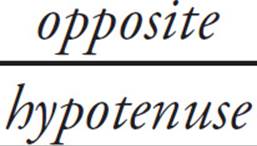 . In the question, this corresponds to sin 35° =
. In the question, this corresponds to sin 35° = 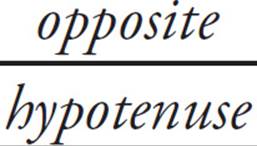 =
= 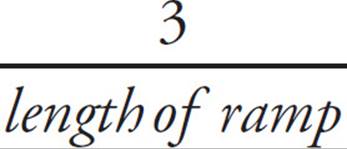 ⇒ length of ramp =
⇒ length of ramp = 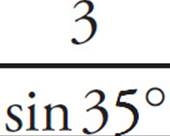 . This is (D).
. This is (D).
7. DThis question requires evaluating both equations to determine the values of a and b. You could begin by solving either of the two equations for a or b, and then substituting the solution into the other equation. But note that the question asks for the value of a + b, so check to see if there’s a faster way: Could you stack and add (or subtract) the equations? If you stack and add the equations, you get 7a + 7b = 77. Now divide both sides of the equation by 7, resulting in a + b = 11. This is (D).
8. DWhen a function f(x) is transformed into a function of the form f(ax), where a is a constant, if a > 0, the function will be compressed horizontally by a factor of a. Here, y = x2 + 4 can be represented as the parent function, and y = 3x2 + 4 as the transformed function compressed horizontally versus the parent function, and thus narrower, by a factor of 3. This is (D). If you’re not sure, try plugging values into each equation to construct a rough graph of each equation and compare them.
9. CRearranging and factoring the expression provided in the question, we have t2 − 4t − 90 = 6 ⇒ t2 − 4t − 96 = 0 ⇒ (t − 12)(t + 8) = 0. Therefore, t − 12 = 0 and t + 8 = 0. t must then equal 12 or −8. If trepresents the number of tickets Steven buys, then only t = 12 is consistent with the context of the question. If each ticket costs $80, Steven must have spent $80 ∙ 12 = $960. This is (C).
10. CWe must find values of c and d by solving the system of equations in order to determine the value of 4c − 4d. There are several ways to go about this. One way is to multiply the terms of the equation 2c+ 3d = 17 by −3 to get −6c − 9d = −51 . If you stack and add this equation with the second equation, the result is −4d = −12, which solves to d = 3. Plug this value for d into the equation 6c + 5d = 39 to get 6c + 15 = 39, so 6c = 24 and c = 4. Therefore, 4c − 4d = 4(4) − 4(3) = 16 − 12 = 4. This is (C).
11. AFactoring the left side of the equation x2 + 2xy + y2 = 64 gives (x + y)2 = 64. Taking the square root of both sides of the equation, we find that x + y = 8 or −8. The other equation provides that y − x = 12, so y = x + 12 . Substitute this value of y into the first equation: either x + (x + 12) = 8, so 2x + 12 = 8, 2x = −4, and x = −2, or else or x + (x + 12) = −8, so 2x + 12 = −8, so 2x = −20, and x = −10. Therefore, x could be either −2 or −10, and only −10 is an option in the answers, so (A) is correct.
12. DTranslate from English to math in bite-sized pieces. Make the price of a hot yoga lesson h and the price of a zero gravity yoga session z. If she offers 2 hot yoga and 3 zero gravity yoga sessions for $400, then 2h + 3z = 400. Similarly, if 4 hot yoga and 2 zero gravity yoga sessions are $440, then 4h + 2z = 440. Now, be sure to Read the Full Question: You want to know whether Samantha can create a package that’s greater than $800 but has fewer than 13 sessions. If you stack the two equations and then add them together, you get 6h + 5z = 880. In other words, she can offer 6 hot yoga and 5 zero gravity yoga sessions (11 total sessions) for $880. This satisfies her requirements, so you know the answer is “Yes”; eliminate (A) and (B). For (C), because you don’t know the price of each lesson individually, you don’t know yet whether 5 hot yoga and 5 zero gravity yoga sessions will be over $800; leave (C) for now. For (D), if 6 hot yoga and 5 zero gravity yoga sessions were over $800, then adding a zero gravity yoga session will still be over $800. Given what you already know, (D) must be true; choose (D).
13. BBegin by simplifying the equation given. (3p2 + 14p + 24) − 2(p2 + 7p + 20) = 3p2 + 14p + 24 − 2p2 − 14p − 40 = p2 − 16 = 0. Factoring the left side of the simplified equation, we find that (p − 4)(p + 4) = 16. Solving for p, we find that p = ±4. The value of 3p + 6 must then be either 3(−4) + 6 = −6 or 3(4) + 6 = 18. The latter value is (B).
14. ATaking note that i =  , the expression (2 + 8i)(1 − 4i) − (3 − 2i)(6 + 4i) becomes (2 + 8
, the expression (2 + 8i)(1 − 4i) − (3 − 2i)(6 + 4i) becomes (2 + 8 )(1 − 4
)(1 − 4 ) − (3 − 2
) − (3 − 2 )(6 + 4
)(6 + 4 ). Expanding, this becomes 2 − 8
). Expanding, this becomes 2 − 8 + 8
+ 8 − 32(
− 32( )2 − (18 + 12
)2 − (18 + 12 − 12
− 12 − 8(
− 8( )2) = 2 − 32(
)2) = 2 − 32( )2 − 18 + 8(
)2 − 18 + 8( )2 = 8(
)2 = 8( )2 − 32(
)2 − 32( )2 − 16. This further simplifies to −8 + 32 − 16 = 8. This is (A).
)2 − 16. This further simplifies to −8 + 32 − 16 = 8. This is (A).
15. CPlug In the Answers! The answers aren’t in order, and some numbers appear more than once, so you don’t need to start in the middle. Instead, start with 9 because it is in three of the four choices. If x= 9, then 2  = 9 − 3.
= 9 − 3.  = 3, so the left side of the equation is 2 × 3 = 6, and the right side of the equation is 9 − 3 = 6. This works, so 9 is part of the solution set; eliminate (B) because it doesn’t include 9. Next, try x = 1: 2
= 3, so the left side of the equation is 2 × 3 = 6, and the right side of the equation is 9 − 3 = 6. This works, so 9 is part of the solution set; eliminate (B) because it doesn’t include 9. Next, try x = 1: 2  = 1 − 3, which solves to 2 = −2. This isn’t true, so 1 is not part of the solution set; eliminate (D). Lastly, try x = −1: 2
= 1 − 3, which solves to 2 = −2. This isn’t true, so 1 is not part of the solution set; eliminate (D). Lastly, try x = −1: 2  = −1 − 3. You cannot take the square root of a negative number, so this doesn’t work. Eliminate (A) and choose (C).
= −1 − 3. You cannot take the square root of a negative number, so this doesn’t work. Eliminate (A) and choose (C).
16. 28Let s equal the number of staples required by the students and let p be the number of popsicle sticks required. If the number of staples the students will need is three times the number of popsicle sticks they will need, then s = 3p. If the students need 84 staples for this project, then s = 84. Substitute 84 for s to get 84 = 3p. Divide both sides by 3 to get 28 = p. The students will need 28 popsicle sticks.
17. 0If a parabola intersects the x-axis at the points (5,0) and (−5,0), it must be symmetric about the x-axis and centered at x = 0. The x-coordinate of its vertical axis of symmetry must then be 0.
18. 94The question describes a 100 foot ramp that forms a triangle. The length of this ramp corresponds to the hypotenuse of a triangle. The height of the ramp is the length of the side of the triangle opposite the 20° angle; the horizontal distance from the start of the ramp immediately below the entrance of the mall is the side of the triangle adjacent to the 20° angle. The function that relates adjacent and hypotenuse is cosine: cosθ = 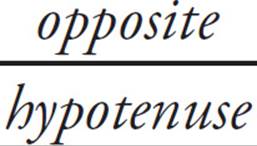 . In this problem, cos 20° =
. In this problem, cos 20° =  , where x is the horizontal distance. Solve by multiplying both sides by 100: cos 20° = x. Next, replace cos 20° with the value given in the problem, 0.939: 100(0.939) = x. Multiply 100 by 0.939 to get x = 93.9, which rounds to 94.
, where x is the horizontal distance. Solve by multiplying both sides by 100: cos 20° = x. Next, replace cos 20° with the value given in the problem, 0.939: 100(0.939) = x. Multiply 100 by 0.939 to get x = 93.9, which rounds to 94.
19. 7Let x equal the number. Then, 2x = x − 5 ⇒ x = −5. Three times that number plus seventeen minus that number is 3(−5) + 17 − (−5) = 7.
20.  3x2 + 2x − 8 = (−2 − x)(4 − 3x) = 0. Solving −2 − x = 0 and 4 − 3x = 0 for x, we find that the two solutions for x are −2 and
3x2 + 2x − 8 = (−2 − x)(4 − 3x) = 0. Solving −2 − x = 0 and 4 − 3x = 0 for x, we find that the two solutions for x are −2 and ![]() . The question asks us to subtract the value of the smaller solution from the larger solution. This difference is
. The question asks us to subtract the value of the smaller solution from the larger solution. This difference is ![]() −(−2) =
−(−2) = ![]() +
+ ![]() =
=  .
.
Section 4: Math (Calculator)
1. BTo solve this question, simply subtract y from both sides of the equation to get 2y = 2, which is (B).
2. AWhenever the question includes variables, plug in. If m = 2, then Merry would pay the one-time enrollment fee plus 2 months’ worth of monthly fees, which is 50 + 15(2) = 80. Plug in 2 for m in the answer choices to see which answer equals the target number of 80. In (A), 15(2) + 50 = 80. This is the target number, so leave this answer, but be sure to check the other choices just in case. In (B), 15 + 50(2) = 115. In (C), 15(2) − 50 = −20, and in (D), (15 + 50)(2) = 130. Since none of the other answer choices equals the target number, the correct answer is (A).
3. BSince the question states that Rob is planning to bring his favorite guitar plus x additional guitars, he will have a total of x + 1 guitars. The question states that the variable x represents the number of additional guitars, so the number 1 must represent Rob’s favorite guitar, which is (B).
4. DThe best way to approach this question is through POE. According to the data in the table, the ratio of those who enjoy biology to those who enjoy chemistry is 14 to 18, which can be reduced to a ratio of 7 to 9; eliminate (A). The ratio of those who enjoy chemistry to those who don’t enjoy chemistry is 18 to 6, which can be reduced to a ratio of 3 to 1; eliminate (B). The ratio of those who enjoy biology to those who don’t enjoy chemistry is 14 to 6, which can be reduced to a ratio of 7 to 3; eliminate (C). The ratio of those who don’t enjoy biology to those who enjoy chemistry is 10 to 18, which can be reduced to a ratio of 5 to 9; this matches (D).
5. CDr. Goldberg takes 40% of substitute A, which consists of 60 grams. Mathematically, this can be expressed as  (60) or (0.4)(60) = 24 grams. She takes 70% of substitute B, which consists of 110 grams. Mathematically, this can be expressed as
(60) or (0.4)(60) = 24 grams. She takes 70% of substitute B, which consists of 110 grams. Mathematically, this can be expressed as  (110) or (0.7)(110) = 77 grams. Substitute C will therefore consist of 24 grams + 77 grams = 101 grams, which is (C).
(110) or (0.7)(110) = 77 grams. Substitute C will therefore consist of 24 grams + 77 grams = 101 grams, which is (C).
6. DTo solve this question, simply factor out the largest value that fits within each of the terms in the expression provided. In this case, x4, x3, and x2 are all divisible by x2, so that is what you will want to factor out. Doing so will leave you with x2 (x2 − x − 1), which is (D).
7. ASince Officer Blake drives 480 miles at a rate of 1 mile per minute, his total drive time was 480 minutes. The question asks for Officer Blake’s driving time in hours, so you need to convert those minutes into hours. Since there are 60 minutes in 1 hour, you can divide 480 minutes by 60 to determine that Officer Blake drove for 8 hours, which is (A).
8. BThe goal here is to isolate x. Since the right-hand side of the equation is −2x + 1, you will want to subtract 1 from both sides, so eliminate (A) and (C). To get x by itself, you will want to divide by −2, not 2, so eliminate (D) and choose (B). Remember that when you multiply or divide across an inequality sign using a negative number, you need to flip the inequality sign in the opposite direction, as reflected in (B).
9. CTo solve this question, rearrange the expressions (2x2 + 4x + 8) and (2x2 − 4x + 7) in order to place the similar terms next to each other. Doing so will give you 2x2 − 2x2 + 4x − (−4x) + 8 − 7 (remember to distribute the negative sign for each of the terms in the second expression). Simplifying this new expression will yield 0 + 8x + 1, or 8x + 1, (C). Another way to approach this question would be to plug in a simple number for x, such as x = 2, and match your target value with the values in the answer choices.
10. AThe tallest hill that Adam measures is 55 feet high. Since 1 foot is equivalent to 12 inches, simply multiply 55 × 12 = 660 inches, (A).
11. BTriangle legs LN and MN are opposite and adjacent, respectively, to ∠y. Therefore, from SOHCAHTOA, we need to use the tangent trigonometric function. Plugging in the values that the question gives us into the equation for tangent, we get tan 40° = 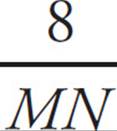 . Now, use your calculator to determine that the length of MN most closely approximates 9.53, which is (B).
. Now, use your calculator to determine that the length of MN most closely approximates 9.53, which is (B).
12. DIf you represent the wooden skateboards with a w and the composite skateboards with a c, you can write two equations based on the information given in the question: 2w + 3c = 650 and 3w + c = 450. It is possible to isolate one of the variables and solve these two equations by substitution, but in this case it is easier simply to stack the equations on top of each other and add them together as follows:
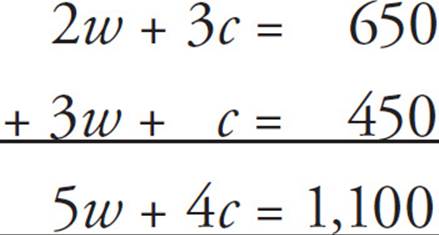
Since the question asks for the price of five wooden skateboards and four composite skateboards, the answer is (D).
13. DThe question states that the number of employees increases at the same rate per year, so you can determine this numerical increase by subtracting one year’s total from the next year’s total. Subtracting the 2013 total from the 2014 total gives 2,110 − 1,890 = 220. To find the total in 2015, add 220 to the 2014 total: 2,110 + 220 = 2,330. The question also states that the male percentages continue to decrease at the same rate, which, based on the data in the table, is 5% per year. The percent male in 2014 was 55%, so the percent male in 2015 will be 50%. 50% of 2,330 can be expressed as or 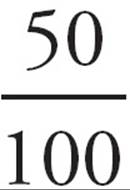 (2330) = 1,165, which is (D).
(2330) = 1,165, which is (D).
14. BThe formula for determining an average can be expressed by Average = 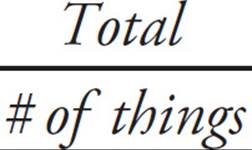 . Plug the values provided into the equation as follows: 11 =
. Plug the values provided into the equation as follows: 11 =  , or 11 =
, or 11 = 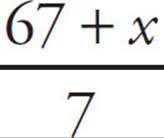 . Multiply both sides by 7 to get 77 = 67 + x. Subtract 67 from both sides to get x = 10, which is (B).
. Multiply both sides by 7 to get 77 = 67 + x. Subtract 67 from both sides to get x = 10, which is (B).
15. CThere are a variety of ways to approach this question. You could solve one equation for s or t and substitute it into the other equation, but look to see if you can do it more simply by stacking and adding (or subtracting) the equations. If you double the first equation to get 34s + 40t = 118, you can then stack and subtract the equations to eliminate t and solve for s, as follows:
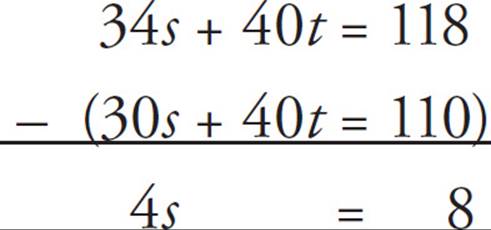
So, 4s = 8 and therefore s = 2. Now plug in 2 for the value of s in one of the equations: 30(2) + 40t = 110, so 40t = 110 − 60, so 40t = 50 and t = ![]() = 1.25. Next, plug s = 2 into the answer choices to determine which one matches your target of 1.25: (C),
= 1.25. Next, plug s = 2 into the answer choices to determine which one matches your target of 1.25: (C), 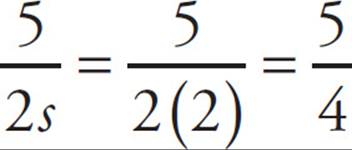 = 1.25.
= 1.25.
16. AThe best way to approach this question is through POE. Choice (A) states that the majority of students polled logged in more times than they posted. The values along the x-axis of the graph are, for most of the data points, higher than the values along the y-axis of the graph, and thus (A) is true according to the data provided. This same data contradicts (B) and (C). You can eliminate (D) because the data does, in fact, allow you to draw a conclusion about the relationship between the variables.
17. BDon’t get too thrown off by the graph. All you need to know to solve this question is that perpendicular lines have slopes that are the negative reciprocals of each other. Since the standard equation for a line is y = mx + b, the slope of the f(x) line is 3. The slope of the h(x) line must therefore be −![]() . The only answer choice that matches is (B).
. The only answer choice that matches is (B).
18. CThe best way to deal with this question is to Plug in the Answers (PITA), starting with (A). If x = 6, then y = 36 = 729. This is less than 4,000, so eliminate (A) and move to the next answer choice. If x = 7, then y = 37 = 2,187. This is still less than 4,000, so eliminate (B). If x = 8, then y = 38 = 6,561. This is greater than 4,000, so (C) must be the correct answer.
19. DThe first step here is to simplify the equation and solve for a. Start by multiplying both sides by 16 to get 16a = 4a2. Divide both sides by 4 to get 4a = a2. Divide both sides by a to get 4 = a. This is now your target answer. Plug a = 4 into the values of a in the answer choices to determine which one matches 4. Choice (D) is the answer, since 2 = 2
= 2 = 2(2) = 4.
= 2(2) = 4.
20. BSince work = rate × time, the 280 in the equation must represent the total number of meals (i.e. the “work”). All three chefs are working together, so they work for the same amount of time, and x must represent that time. The coefficients 8, 4, and 2 must therefore represent the chefs’ respective rates, or how many meals each prepares in a set amount of time. Since 8 is the greatest of these three coefficients, 8x must be the meal output of the fastest chef, either (B) or (C). Now you need to solve the equation: 8x + 4x + 2x = 280. Combining like terms gives you 14x = 280. Divide both sides by 14 to determine that x = 20. This number represents the amount of time that the chefs worked, so the actual number of meals prepared by the fastest chef would be 8 × 20 = 160 meals, which is (B).
21. DStart by finding the slope of the line provided on the graph using the points (0,−4) and (6,0) and the point-slope formula:  . When this line is reflected across the line y = x, the x and y values switch, so the new slope would be the reciprocal of the original slope. Since our original slope was
. When this line is reflected across the line y = x, the x and y values switch, so the new slope would be the reciprocal of the original slope. Since our original slope was ![]() , our new slope will be
, our new slope will be ![]() . The numerator here reflects the gain or loss of pieces of fruit in the harvest, and the denominator reflects the nutrients subtracted or added. This means that for every two nutrients added, there will be a harvest gain of three pieces of fruit, which is (D).
. The numerator here reflects the gain or loss of pieces of fruit in the harvest, and the denominator reflects the nutrients subtracted or added. This means that for every two nutrients added, there will be a harvest gain of three pieces of fruit, which is (D).
22. DThe issue that needs clarification here is whether the students polled by Joe thought that a score of 1 or a score of 5 was good. Since (A) and (C) deal with George’s poll, they would do nothing to help clarify this ambiguity. Choice (B) might help us to figure out which of the students Joe polled were interested in the Model UN Club; it would not help to determine whether 1 or 5 was the best rating. Choice (D) is thus the best answer.
23. CIn order to determine the normal cost for renting skis and snowboards, you need to write two equations and then manipulate and solve those equations. If you call skis x and snowboards y, your two equations will be 5x + 2y = 370 and 3x + 4y = 390. Look for a way to stack and add the equations to eliminate one of the variables. For instance, multiply the first equation by 2 to get 10x + 4y = 740, and then stack and subtract the equations, as follows:
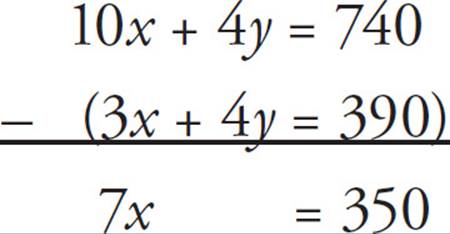
So, 7x = 350 and x = 50, so the price of a pair of skis is $50. Plug this number back into either equation to find the cost of a snowboard: 10(50) + 4y = 740, so 4y = 740 − 500 and 4y = 240. Therefore, y = 60, the cost of a snowboard. So, the cost of two pairs of skis and two snowboards would normally be 2(50) + 2(60) = 100 + 120 = 220. Finally, remember that prices are discounted by 10%, so multiply the price of $220 by 10% to get $22, and subtract $22 from the price. The final cost of two pairs of skis and two snowboards is 220 − 22 = 198, which is (C).
24. AStart by simplifying 8x + 8y = 18 by dividing each term by 8: x + y =  or : x + y =
or : x + y = ![]() . The second equation provided in the question can be factored: x2 − y2 is the same as (x + y)(x − y), so the second equation can also be written (x + y)(x − y) = −
. The second equation provided in the question can be factored: x2 − y2 is the same as (x + y)(x − y), so the second equation can also be written (x + y)(x − y) = −![]() . Since you know that x + y =
. Since you know that x + y = ![]() , you can rewrite the second equation as
, you can rewrite the second equation as ![]() (x − y) = −
(x − y) = −![]() . Multiply both sides by :
. Multiply both sides by : ![]() : x − y = –
: x − y = –![]() (
(![]() ) or x − y = −
) or x − y = −![]() . Since the question asks for the value of 2x − 2y, simply multiply everything by 2: 2(x − y) = 2(−
. Since the question asks for the value of 2x − 2y, simply multiply everything by 2: 2(x − y) = 2(−![]() ) = −
) = −![]() , which is (A).
, which is (A).
25. DIf each minute of his workout time burns 50 calories, and he wants to consume no fewer than 2,000 calories, Shaun must work out for a minimum of 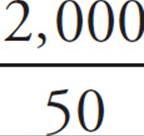 = 40 minutes. If he wants to consume no more than 2,500 calories, Shaun must work out for a maximum of
= 40 minutes. If he wants to consume no more than 2,500 calories, Shaun must work out for a maximum of  = 50 minutes. Since the question asks for the inequality that represents the number of minutes for which Shaun will burn off as many calories as he consumes, (D) is correct, as it includes both the minimum (40 minutes) and maximum (50 minutes) amount of time that he can work out. Choice (C) is incorrect because the answer should include 50 (he can work out for a “maximum” of 50 minutes, so he could work out for 50 minutes), but the lesser than sign (“<”) excludes 50.
= 50 minutes. Since the question asks for the inequality that represents the number of minutes for which Shaun will burn off as many calories as he consumes, (D) is correct, as it includes both the minimum (40 minutes) and maximum (50 minutes) amount of time that he can work out. Choice (C) is incorrect because the answer should include 50 (he can work out for a “maximum” of 50 minutes, so he could work out for 50 minutes), but the lesser than sign (“<”) excludes 50.
26. AThere are 162 games in the season, so the team needs a total of 162 × 45,500 = 7,371,000 ticket purchases to have a mean of 45,500 ticket purchases per game for the season. The 60 games with an average total ticket purchase of 43,000 gives a total of 2,580,000 ticket purchases, leaving 4,791,000 ticket purchases left for the team to reach its goal. Dividing 4,791,000 by 102 makes (A) the closest value to the average of 46,971 ticket purchases per game the team needs to make.
27. BThe best way to deal with this question is through POE. If the polynomial has zeroes of 2 and −3, then that means you have two points: (2,0) and (−3,0)—eliminate (A) and (C). Since it is given in the question that a > 0 when the parabola is in the form y = ax2 + bx + c, the parabola must be pointed upwards—eliminate (D) and choose (B).
28. ASince the radius of the circle is 4, the area of the entire circle is πr2 = π(42) = 16π. Sector POR has an area of 8π and sector ROQ has an area of 6π, so the remaining sector (QOP) has an area of 16π − 8π − 6π = 2π. You can set up a proportion to determine the associated angle using the following formula:  . Using the numbers you now have, your calculation will look like this:
. Using the numbers you now have, your calculation will look like this: or
or ![]() =
= 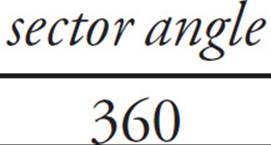 . Multiply both sides of the equation by 360 to determine that the sector angle is 45°, which is (A).
. Multiply both sides of the equation by 360 to determine that the sector angle is 45°, which is (A).
29. D16% of the 200 medical residents named oncology as their first choice:  (200) or (0.16)(200) = 32 residents. 40% of the 200 medical residents named cardiology as their first choice:
(200) or (0.16)(200) = 32 residents. 40% of the 200 medical residents named cardiology as their first choice:  (200) or (0.4)(200) = 80 residents. Of these 80 residents, 20% chose oncology as their second choice:
(200) or (0.4)(200) = 80 residents. Of these 80 residents, 20% chose oncology as their second choice:  (80) or (0.2)(80) = 16 residents. The total number of residents who named oncology as either their first or second choice was therefore 32 + 16 = 48 residents. To find the value of x, you need to subtract the percentages given in the question from the total, 100%: 100 − 40 − 16 − 34 = x = 10%. Now, plug x = 10 into the answer choices in order to determine which one matches your target of 48 residents. Only (D) works: x2 − 24x + 188 = 100 − 24(10) + 188 = 100 − 240 + 188 = 48.
(80) or (0.2)(80) = 16 residents. The total number of residents who named oncology as either their first or second choice was therefore 32 + 16 = 48 residents. To find the value of x, you need to subtract the percentages given in the question from the total, 100%: 100 − 40 − 16 − 34 = x = 10%. Now, plug x = 10 into the answer choices in order to determine which one matches your target of 48 residents. Only (D) works: x2 − 24x + 188 = 100 − 24(10) + 188 = 100 − 240 + 188 = 48.
30. BIf the original graph is reflected across the x-axis, the x-values will remain the same but the y-values will switch signs. Since the y-axis represents distance from start, negative y-values means that the car is now going in reverse. The only answer that matches this information is (B).
31. 30Translate English to math. “What number divided by two is equal to that same number minus 15?” can be written as an equation, with x representing the missing number: ![]() = x − 15. Add 15 to both sides of the equation to get
= x − 15. Add 15 to both sides of the equation to get ![]() + 15 = x. Subtract
+ 15 = x. Subtract ![]() from both sides to get 15 =
from both sides to get 15 = ![]() . Multiply both sides by 2 to get x = 30.
. Multiply both sides by 2 to get x = 30.
32. 4When dealing with values that are directly proportional, you can use the equation 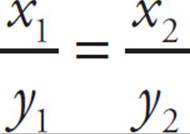 . For this question, you can call the number of hours spent playing Call of Destiny x and the number of hours spent in the game room y. Your equation will then look like this:
. For this question, you can call the number of hours spent playing Call of Destiny x and the number of hours spent in the game room y. Your equation will then look like this: 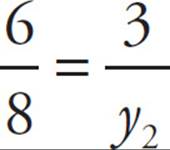 . Cross-multiply to get 6y2 = 3(8) or 6y2 = 24. Divide both sides of the equation by 6 to get y2 = 4.
. Cross-multiply to get 6y2 = 3(8) or 6y2 = 24. Divide both sides of the equation by 6 to get y2 = 4.
33. 13.5Start by translating English to math. Make s the price of Smooth-Glide pens and e the price of Easy-Write pencils. If 12 pens and 8 pencils cost $16, then 12s + 8e = 16. Similarly, if 6 pens and 10 pencils cost $11, then 6s + 10e = 11. Remember to Read the Full Question! The question wants the price of 9 pens and 9 pencils. If you stack the equations and add, you get 18s + 18e = 27. This is exactly double the number of pens and pencils you want, so divide the entire equation by 2 to get 9s + 9e = 13.5.
34. 2or 
There are a few different ways to approach this question. Since the calculator is permitted on this section of the test, you can put the equation into the standard ax2 + bx + c = 0 form and plug that equation into the “y =” button on your graphing calculator. The equation, once rearranged, is 3x2 − 16x + 20 = 0. You can trace the graph or use the “calc” feature to calculate the zeroes, which are the same as the values of x. Doing so will yield values of x = 2 and x = 3.33. Alternatively, you can factor the equation the long way or use the quadratic formula, 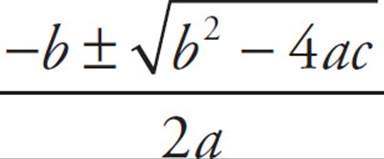 . In this equation, a = 3, b= −16, and c = 20. Plugging those values into the equation, you get
. In this equation, a = 3, b= −16, and c = 20. Plugging those values into the equation, you get  . Therefore, the solutions are
. Therefore, the solutions are  and
and 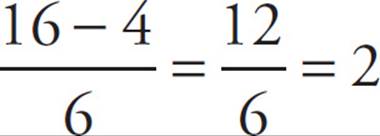 . Either value (
. Either value ( or 2) is a valid answer.
or 2) is a valid answer.
35. 5Since you are looking for the value of x for which the population surpassed the number of dwellings, you can set up an inequality: 3x > 2x + 100. Now, simply plug in values for x starting with x = 1 until the left-hand side of the inequality is larger than the right-hand side. Using the values x = 1, x = 2, x = 3, and x = 4, you will find that the left-hand side of the inequality is less than the right-hand side. Using x = 5, 35 = 243, and 2(5) + 100 = 110, making the left-hand of the inequality greater than the right-hand side. Therefore, the answer is 5.
36. 5,406The first step here is to add Team Charlie’s and Team Delta’s total currents together as follows:
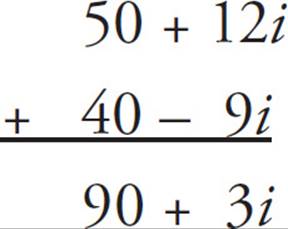
Next, use FOIL to multiply this value by the total current from Team Epsilon: (90 + 3i) (60 − 2i) = 5,400 − 90(2i) + 60(3i) − 2i(3i) = 5400 − 180i + 180i − 6i2 = 5,400 − 6i2. Since i2 = −1, this is equivalent to 5,400 − 6(−1) = 5,400 + 6 = 5,406. If you have a calculator that is able to deal with imaginary numbers, you can simply type the expressions into your calculator, which will solve everything for you.
37. 860The question states that there are 2,400 total inhabitants of Centre Hill, so if there are an equal number of adults and children, then there are 1,200 of each. Since there are 200 more adult females than adult males, you can set up two equations: f + m = 1,200 and f = m + 200. You can rewrite the second equation by subtracting m from both sides: f − m = 200. Next, stack and add the two equations as follows:
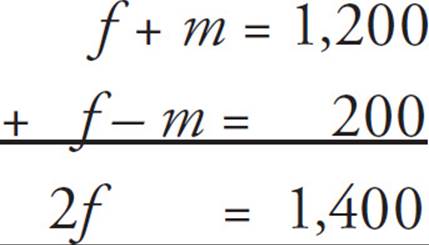
Divide both sides of the equation by 2 to determine that f = 700. The number of women living uptown is therefore 8% of 700:  (700) or (0.08)(700) = 56. The number of children living in the suburbs is 67% of 1,200:
(700) or (0.08)(700) = 56. The number of children living in the suburbs is 67% of 1,200:  (1,200) or (0.67)(1,200) = 804. The sum of these two figures is 56 + 804 = 860.
(1,200) or (0.67)(1,200) = 804. The sum of these two figures is 56 + 804 = 860.
38. 250Using your information from question 37, you can determine that the total number of adult males prior to the addition of the annex is 1,200 − 700 = 500. The original percentage of adult males living Uptown is 9% of 500:  (500) or (0.09)(500) = 45. Since the question states that the percentage of adult males living Uptown decreases to 6%, you can conclude that the 45 adult males living Uptown after the annexation constitute 6% of the total adult male population: 45 =
(500) or (0.09)(500) = 45. Since the question states that the percentage of adult males living Uptown decreases to 6%, you can conclude that the 45 adult males living Uptown after the annexation constitute 6% of the total adult male population: 45 =  (x) or 45 = (0.06)x. Divide both sides of the equation by 0.06 to determine that x = 750. Since the original number of adult males was 500, 750 − 500 = 250 additional adult males live in The Annex.
(x) or 45 = (0.06)x. Divide both sides of the equation by 0.06 to determine that x = 750. Since the original number of adult males was 500, 750 − 500 = 250 additional adult males live in The Annex.